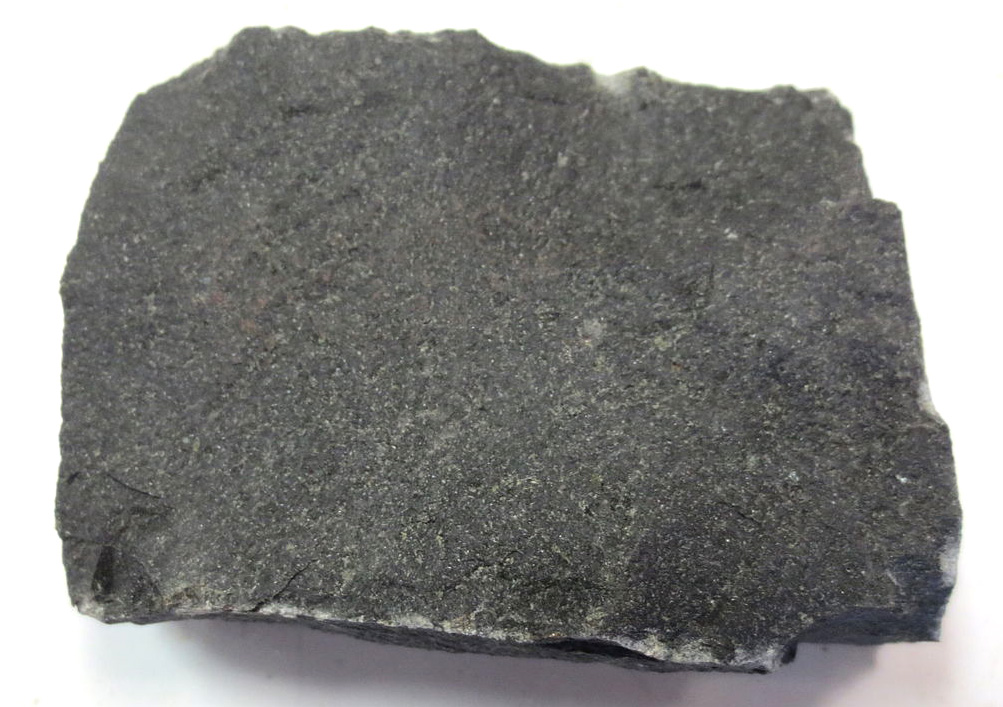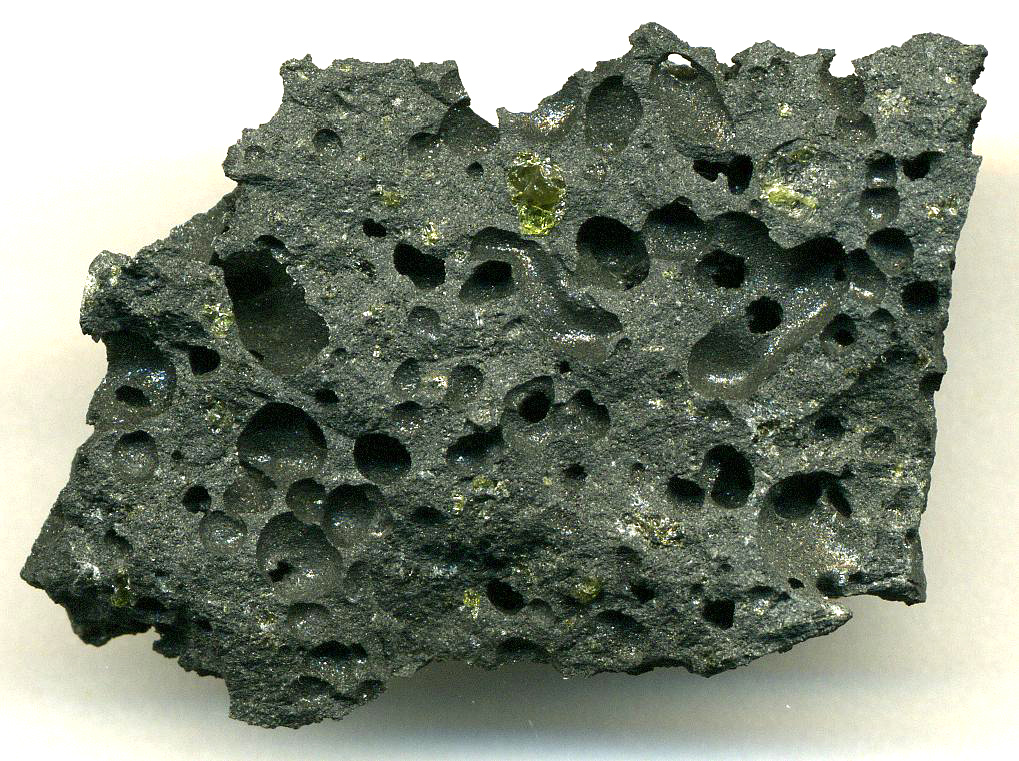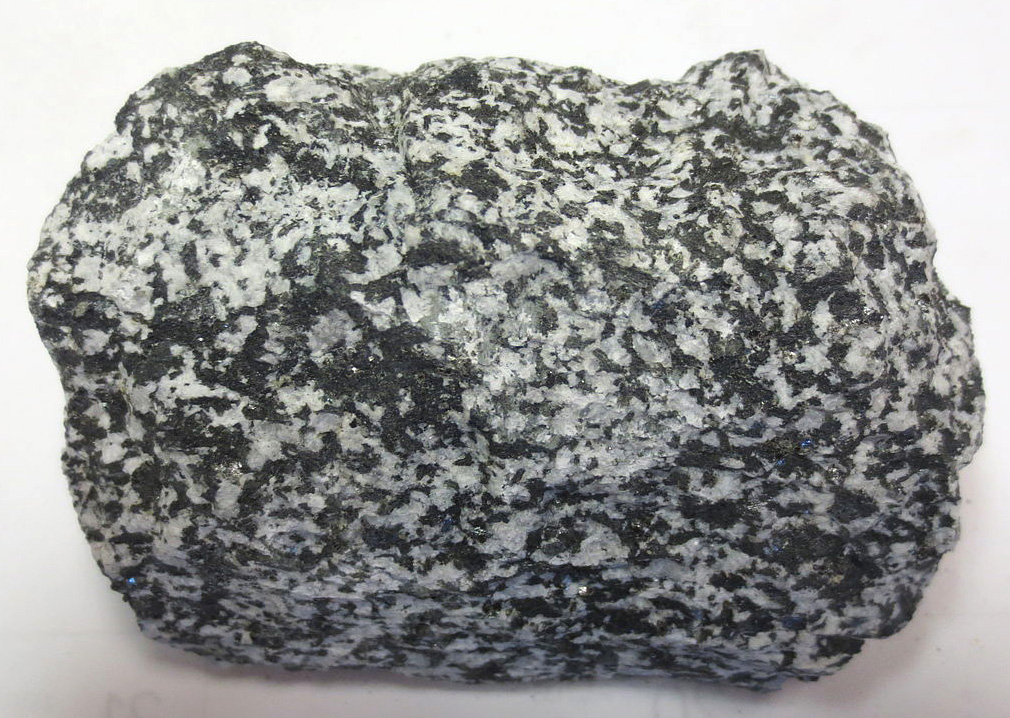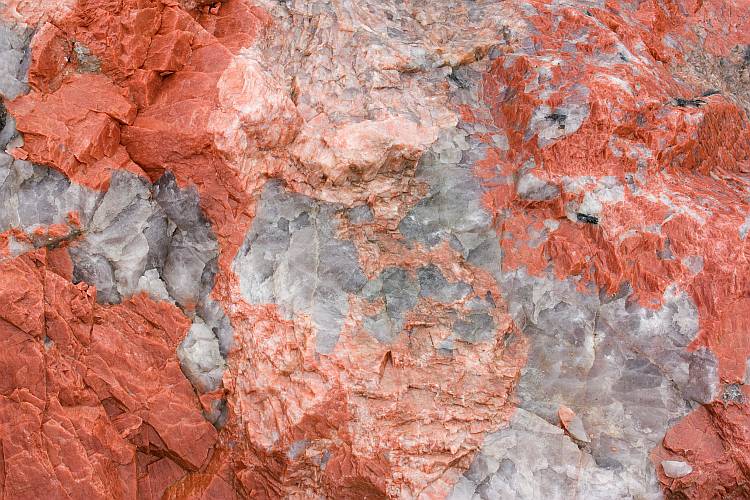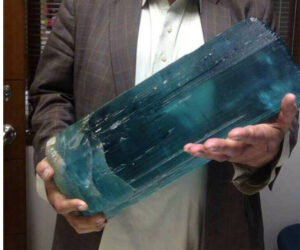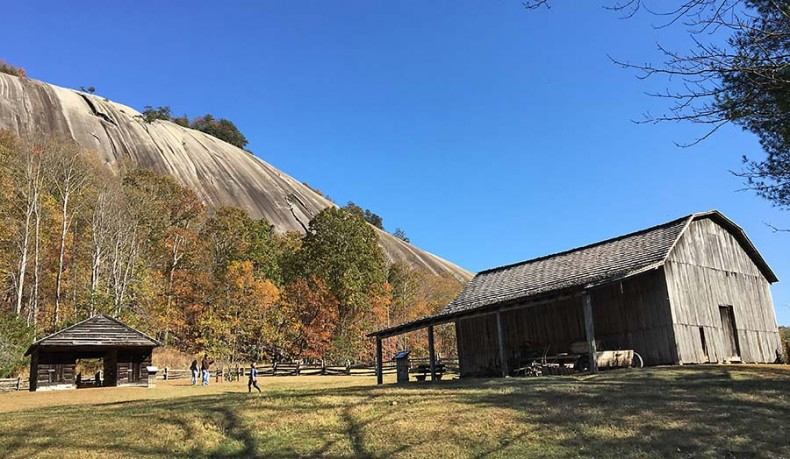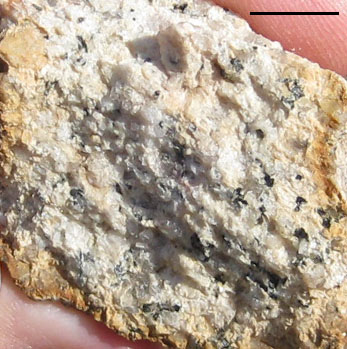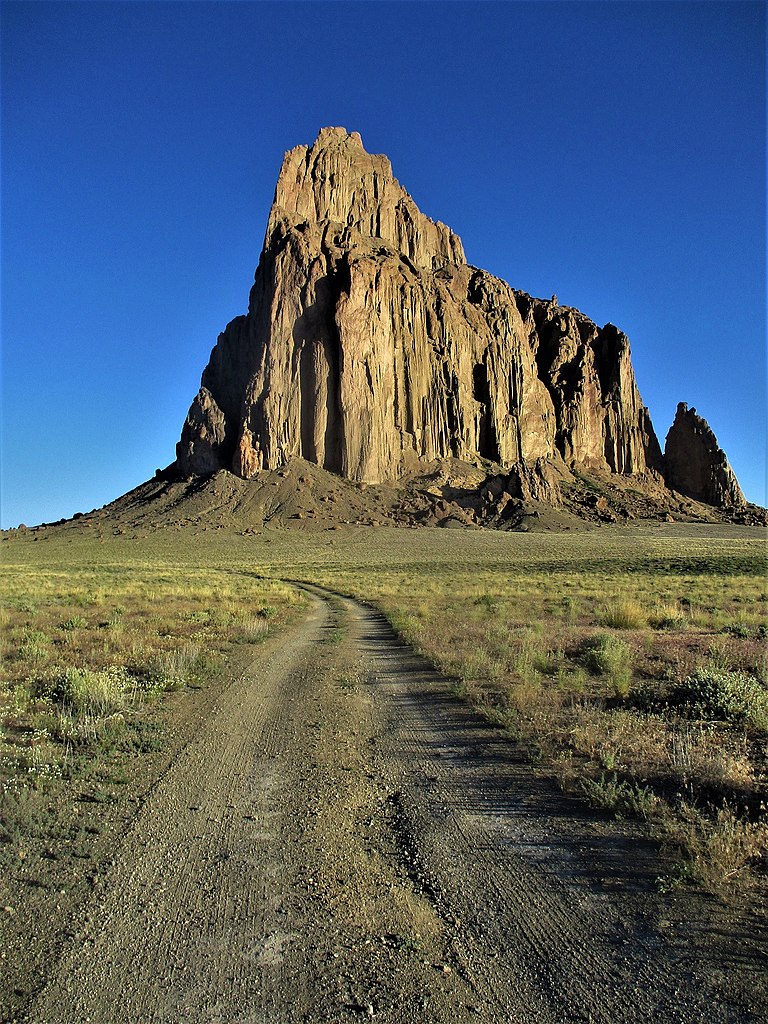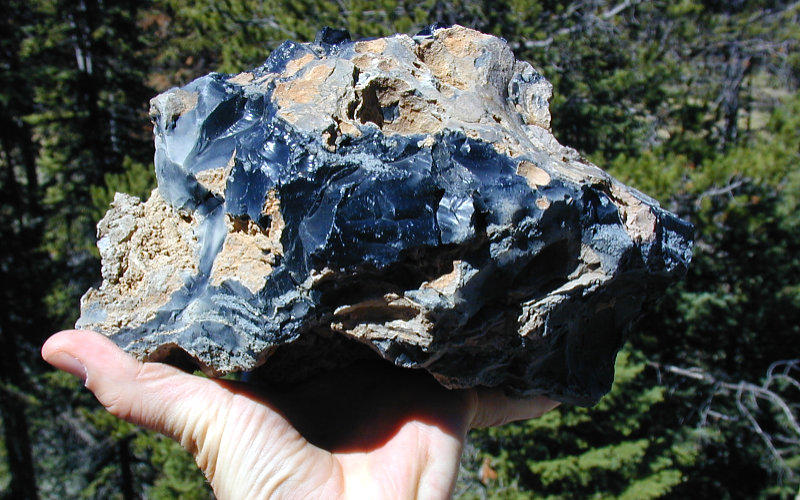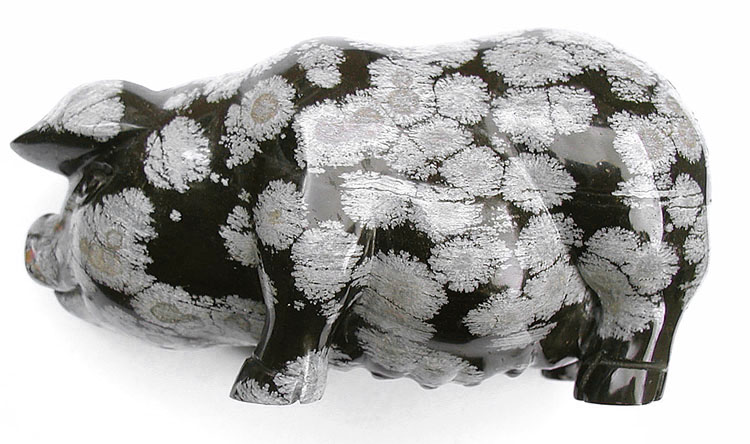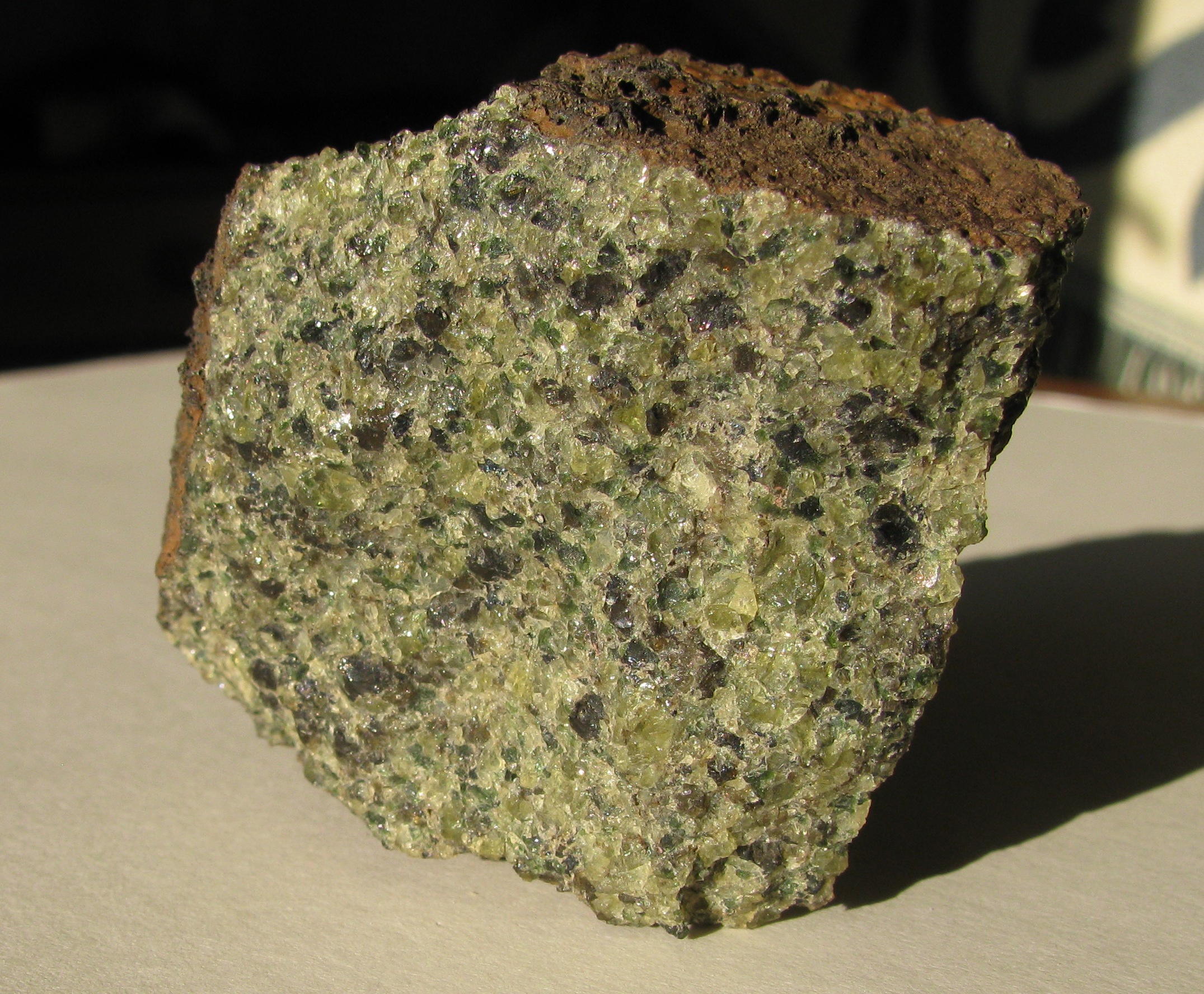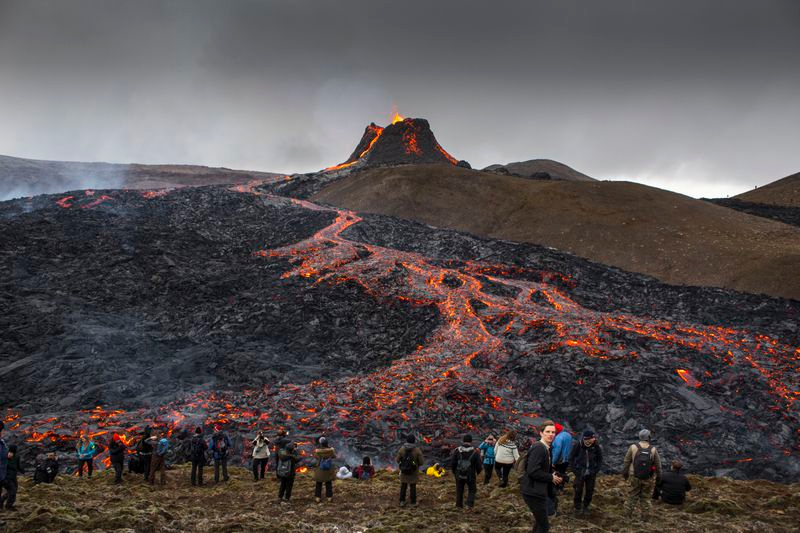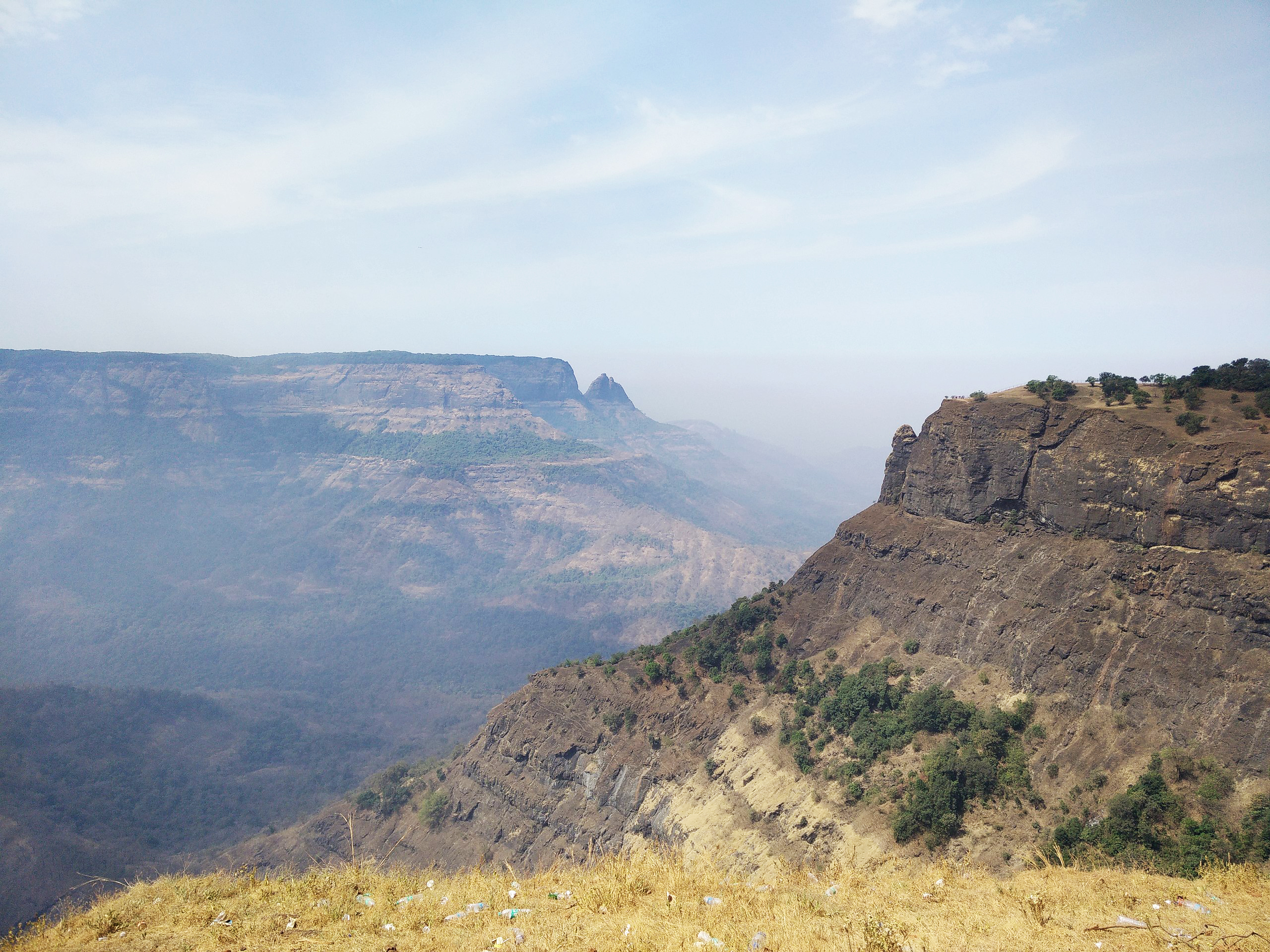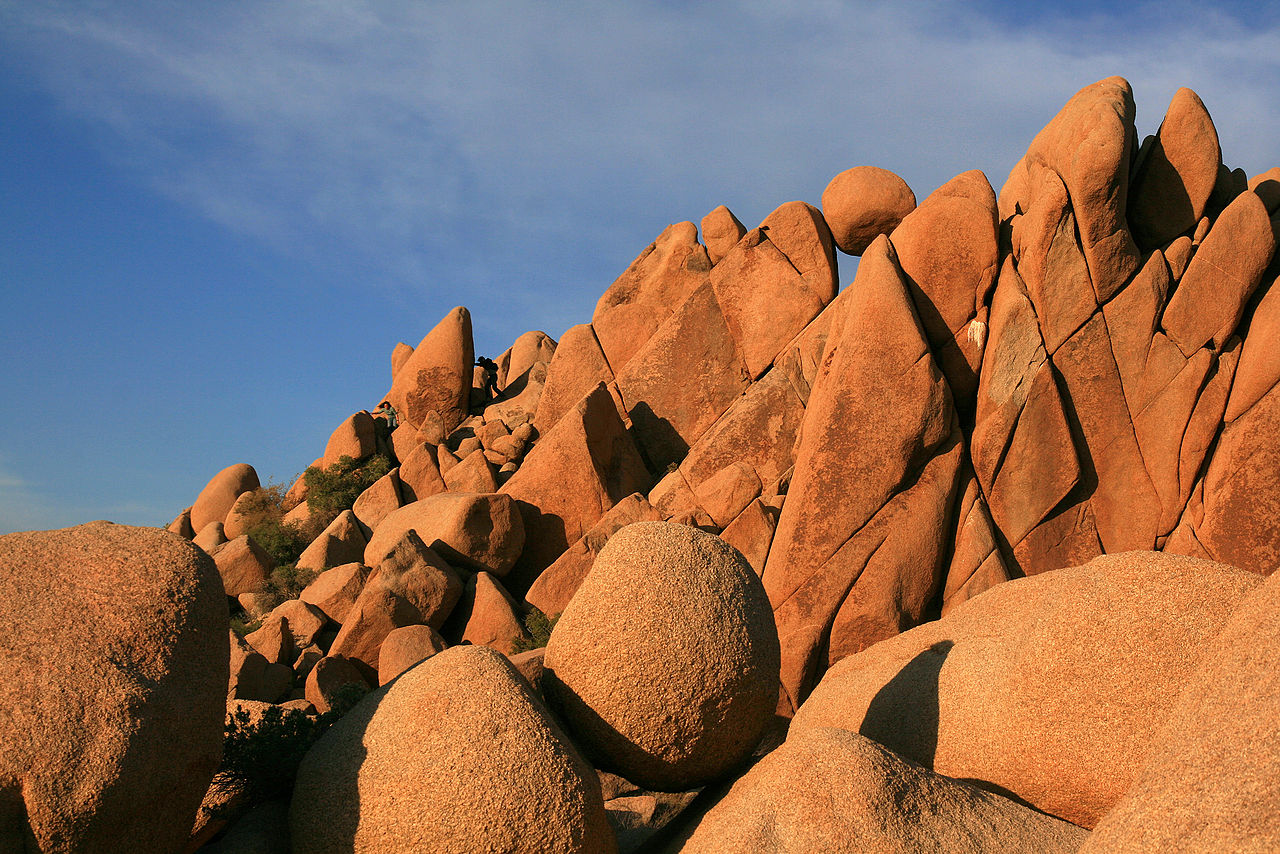
Rounded outcrops of granite, Joshua Tree National Park, California. Note two people for scale.
KEY CONCEPTS
- Igneous petrology involves the study of the origin and nature of magma.
- Igneous petrology also involves the identification, classification, origin, evolution, and processes of formation and crystallization of igneous rocks.
- Igneous rocks conveniently divide into extrusive rocks, also called volcanic rocks, and intrusive rocks, also called plutonic rocks.
- Most volcanic rocks are associated with lithospheric plate boundaries, but some originate at hot spots or rifts.
- Plutonic rocks may form in all the places where volcanic rocks form but we only see them if they are uplifted and exposed by erosion.
- Common igneous rocks contain 45-65 wt% SiO2. Other common and important components include Al2O3, FeO, Fe2O3, CaO, Na2O, K2O, and MgO.
- Minerals in different igneous rocks reflect overall rock composition.
- The most common minerals in igneous rocks are quartz, K-feldspar, plagioclase, muscovite, biotite, amphibole, pyroxene, and olivine.
2.1 Igneous Petrology
Igneous petrologists study many kinds of magmatic rocks and processes that create them. The studies are essential as petrologists seek to understand the origin and evolution of Earth, to understand and predict phenomena such as volcanism that can be important in our daily lives, and to find some of Earth’s most important natural resources. Igneous petrologists also investigate the distribution of igneous activity around the globe and how it relates to plate tectonics. Some petrologists even study igneous activity on other planets. But no matter what their focus, most igneous petrologists seek to understand the origin and nature of magma, and the formation of igneous rocks.
2.2 Extrusive and Intrusive Rocks
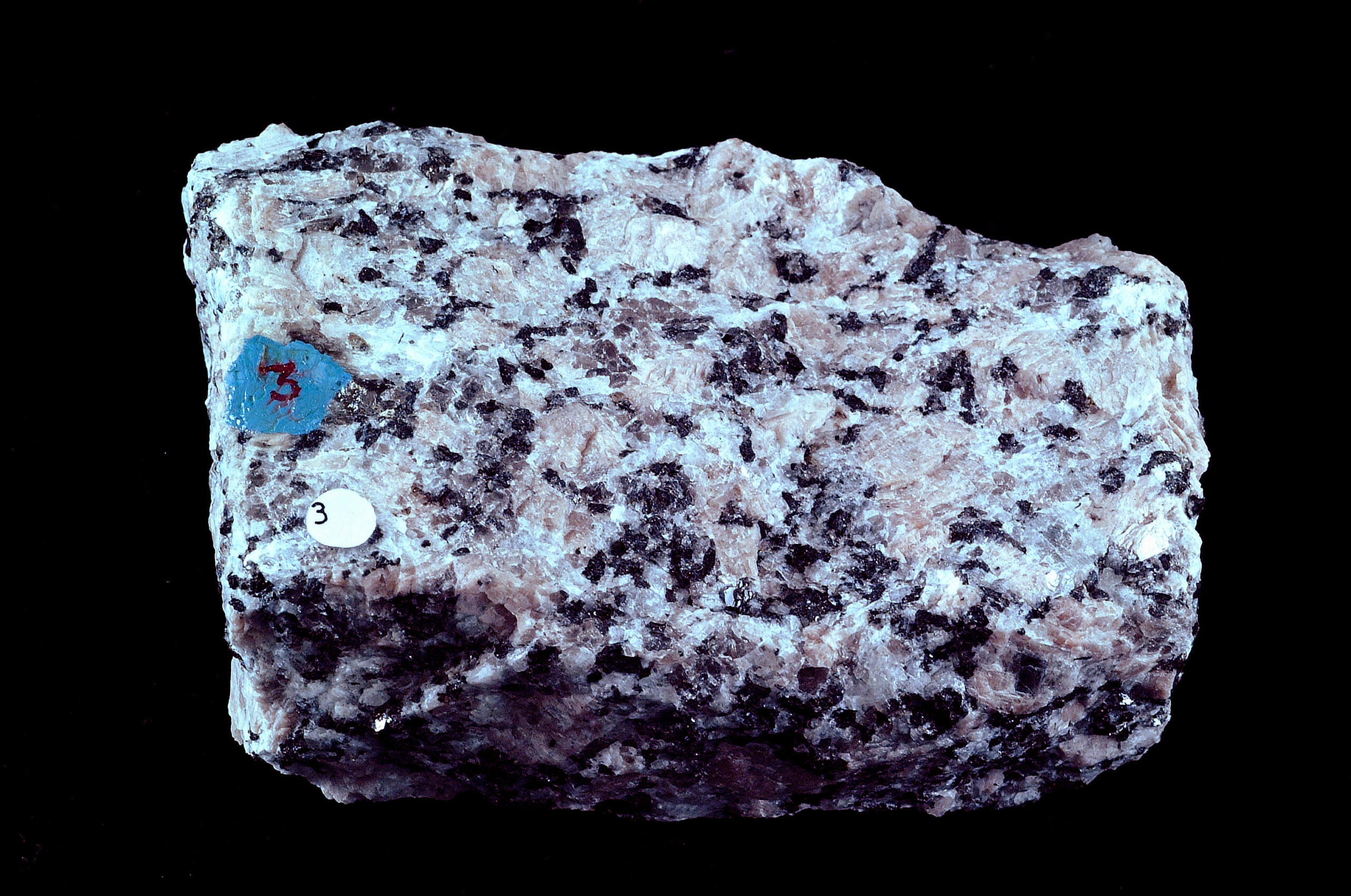
When magma cools, it solidifies, commonly crystallizing to form individual mineral crystals. Figure 2.1 shows an example – a granite that contains pale pink orthoclase, white plagioclase, gray quartz, black hornblende, and black biotite.
Cooling and crystallization can occur quickly during eruptions at Earth’s surface. They can also occur slowly by underground cooling over millions of years, or by mixed processes involving both slow and fast cooling. Crystal formation takes time because atoms must migrate and bond in an organized arrangement. If cooling is too rapid for large crystals to form, the melt may solidify with only microscopic crystals, or it may form volcanic glass to produce a vitreous rock. Thus, mineral and glass fragments range from microscopic to very large (up to 10’s of meters in one dimension) depending on cooling rate and magma composition.
Magmas that erupt at Earth’s surface as lava flows, or as material that explodes into the air, cool quickly to produce extrusive rocks (so called because the magmas extrude at Earth’s surface). Extrusive rocks contrast with intrusive rocks that crystallize slowly when magma cools underground. Figure 2.2 shows a sample of basalt, the most common kind of extrusive rock. The grain size is so small that individual mineral crystals cannot be distinguished. Figure 2.3 is a different basalt that contains visible green crystals of olivine. The cover photo in Chapter 1 showed a close-up of a similar basalt.
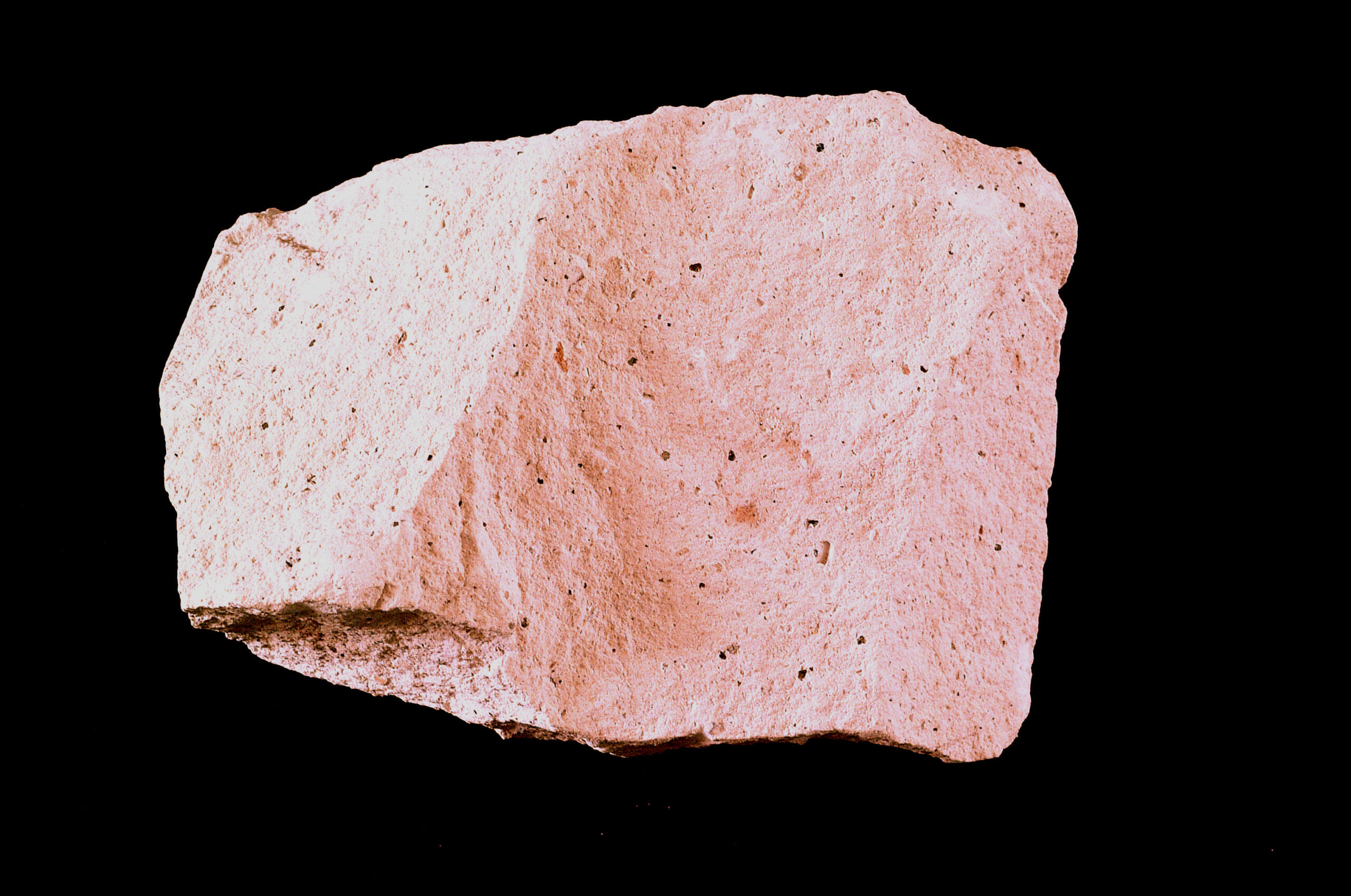
Figure 2.4 is a typical rhyolite, an SiO2-rich extrusive rock (in contrast with basalt which is relatively SiO2-poor). The minerals it contains (K-feldspar and quartz) are so fine grained that we cannot see them in the hand specimen. The reddish color, however suggests the rock contains K-feldspar, a mineral that often has a salmon or reddish color.
Grain size is generally the most significant difference between extrusive and intrusive rocks. We use the adjective aphanitic to describe extrusive rocks such as basalt or rhyolite that contain grains too small to see with the naked eye. Coarser rocks, containing mostly visible crystals, are phaneritic. Warm rocks commonly surround magmas that are underground, so the magmas cool and crystallize slowly, perhaps only 1 to several degrees in 1,000 years. This is why intrusive rocks typically contain coarse crystals. In contrast, magmas that reach the surface cool quickly, leaving little time for crystals to grow, and thus producing extrusive rocks with fine grain size.
Overall, due to contrasting cooling rates, most phaneritic rocks have an intrusive origin and most aphanitic rocks have an extrusive origin. There are exceptions, however. For example, fine grained intrusive rocks can be found in narrow dikes that cool quickly after intrusion, and some coarse-grained extrusive rocks can be found in the bottom layers of thick lava flows.

Extrusive rocks are often associated with volcanoes (but need not be). Nonetheless, the adjective volcanic is commonly used as a synonym for extrusive – to describe any rock formed from magma that reached the surface. Figure 2.5 shows blocks of dacite produced by eruption in Lassen Volcanic National Park. Dacite is a common volcanic rock that contains mostly plagioclase and quartz.
Magma reservoirs, also called magma chambers, exist beneath most volcanos. Magmas have low densities compared with solid rocks. So, they are buoyant and naturally tend to rise toward the surface. While rising, they cool. If magma reaches Earth’s surface, we may get a volcanic rock such as the ones in Figures 2.1 to 2.5. However, magma may crystallize at depth to produce an intrusive rock. Intrusive rocks sometimes form large rock bodies called plutons. So, although perhaps technically incorrect, the terms intrusive and plutonic are used interchangeably to describe any coarse grained igneous rock. Some intrusive rocks, however may be quite fine-grained, and many do not form as plutons.
|
|
|
Figures 2.6 and 2.7 are two examples of plutonic rocks. The largest crystals in the diorite (Figure 2.6) are visible but under a centimeter in longest dimension. This is typical for a diorite, but crystals in some rocks are much larger. For example, some crystals in the pegmatite seen in Figure 2.7 are up to 15-20 centimeters across. (Pegmatite is a name we use for any exceptionally coarse grained igneous rock. See Box 2.1). The largest crystals in the granite we saw above (Figure 2.1) were slightly under a half centimeter across.
Due to fast cooling, many volcanic rocks contain no visible crystals at all. They may contain small crystals that require a microscope to see or they may be entirely glass. However, if crystals begin to grow in magma chambers before eruption, relatively large mineral crystals called phenocrysts, surrounded by partially melted material, may form. Upon eruption, the remaining molten material will cool quickly, encasing the phenocrysts in a fine-grained groundmass, and creating a rock with a porphyritic texture. We call such rocks, which form by a combination of intrusive and extrusive processes, porphyries. The rock in Figure 2.3, for example, is a basalt porphyry containing phenocrysts of olivine. Because groundmass solidifies rapidly during late stages of cooling, it may be partly or entirely volcanic glass.
Porphyritic rocks vary greatly in appearance; the three photos below show examples. The so-called imperial porphyry on the left is a decorative building stone originating in Egypt. It is an altered andesite or dacite that contains millimeter-sized white feldspar phenocrysts. The porphyritic basalt in the middle contains plagioclase phenocrysts up to several centimeters long. The most obvious examples of porphyritic rocks are volcanic, but plutonic rocks may have a porphyritic texture too. The example on the right below is an example – a porphyritic granite that contains large pink crystals of K-feldspar surrounded by smaller crystals of white plagioclase, gray quartz, and black biotite.

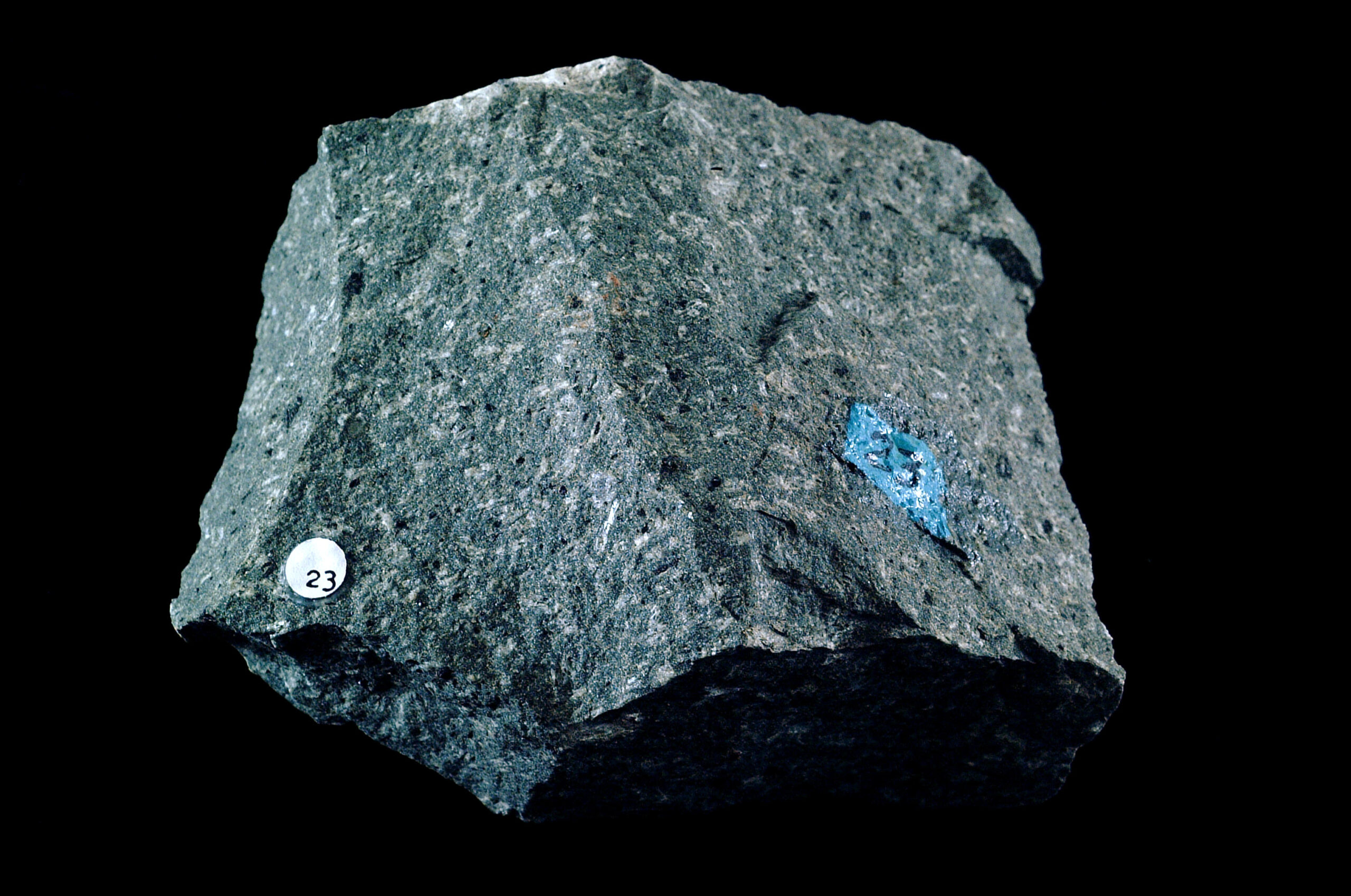
Figure 2.10 is a photo of porphyritic latite. Latite is a kind of extrusive rock that contains about equal amounts of plagioclase and K-feldspar, with little quartz. The light gray, somewhat rectangular, crystals are phenocrysts of plagioclase up to 6 mm long. This rock also contains phenocrysts of black clinopyroxene that are just barely visible in the photo if you enlarge it. The dark gray groundmass between the phenocrysts is a mix of feldspars, pyroxene, biotite, and magnetite. The two grain sizes suggest a two-stage cooling history. The phenocrysts grew slowly over a long time before eruption (as evidenced by their size). Subsequently, magma containing the crystals moved upward and, during rapid cooling at Earth’s surface, the finer grained groundmass solidified.
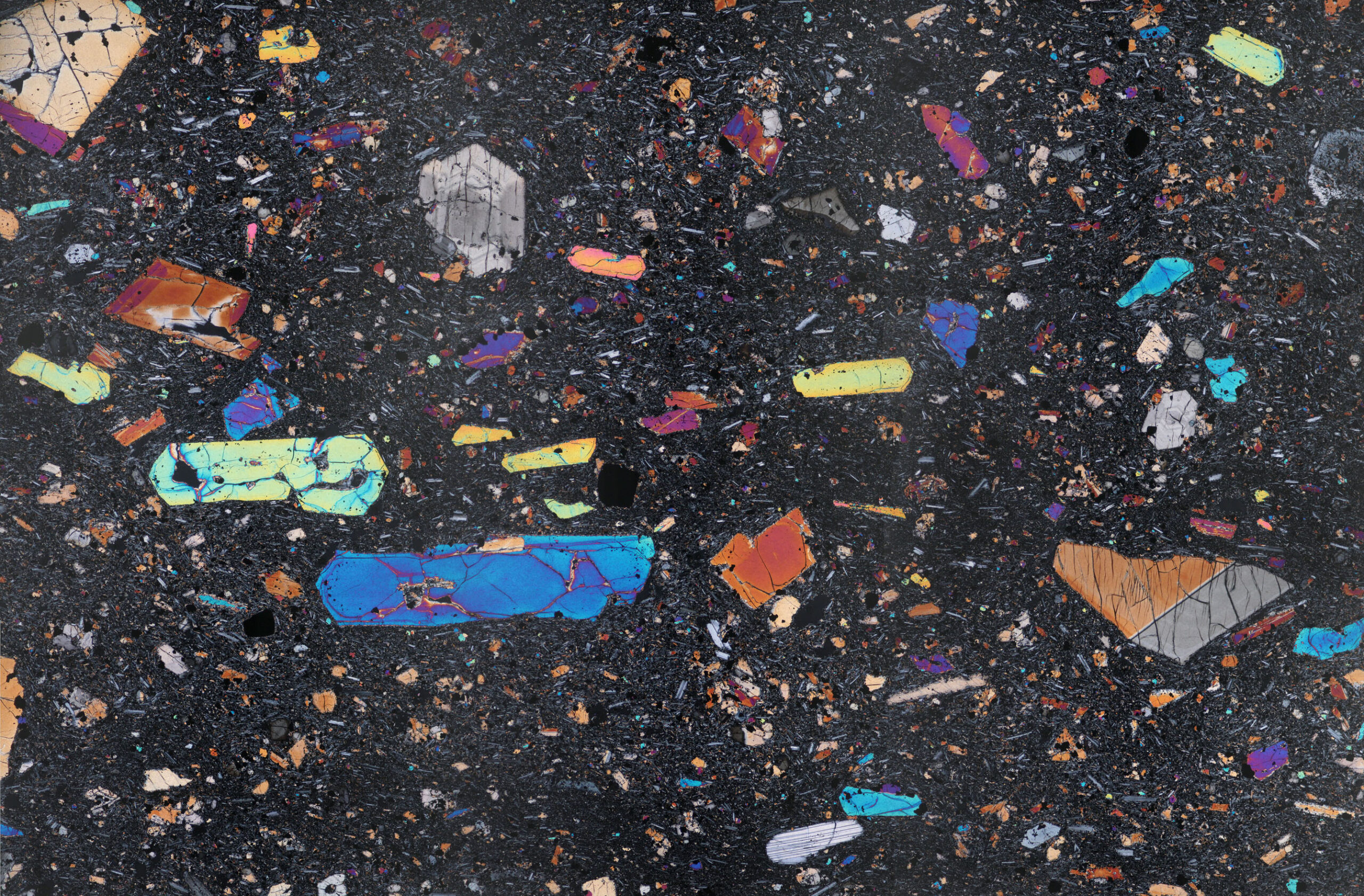
Phenocrysts in porphyritic volcanic rocks may be quite small. Figure 2.11 is a microscope view of a thin section of a basalt from France. The photo was taken using crossed polarizing filters, so the colors are not true mineral colors. Most of the brightly colored mineral crystals are augite, a kind of pyroxene; the largest augite crystals are about half a centimeter long. Smaller, and hard to see gray and white phenocrysts are crystals of plagioclase, all much less than a centimeter in length. The groundmass between phenocrysts is mostly volcanic glass; glass (because it is not crystalline) always appears black when viewed with crossed polarizing filters.
2.2.1 Volcanic Rocks
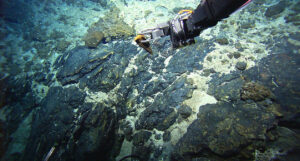
Volcanic rocks cover just less than 10% of Earth’s surface. They may be found in different geological settings, but eruptions at lithospheric plate boundaries account for most of them – 75% at mid-ocean ridge spreading centers alone. Mid-ocean ridge basalt (MORB), the most common volcanic rock, covers the world’s ocean floors. We do not, however, get to see MORB very often. But sometimes submersibles take pictures or even acquire samples. Figure 2.12 is a photo of a robotic arm collecting samples of the Mid-Atlantic Ridge near the equator.
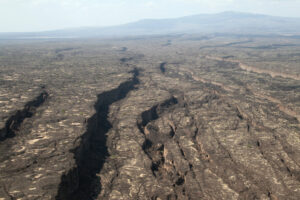
About 15% of all volcanic rocks are associated with subduction zones. Lesser amounts are found at continental rifts where continental lithosphere is splitting apart, and at hot spots where mantle plumes bring extra heat to the surface. Figure 2.13 is a photo of voluminous basalt flows in the East African Rift region of Ethiopia, near where the Red Sea and the Gulf of Aden come together. This rift zone extends thousand of kilometers into Africa’s interior and basalt can be found along the entire distance. Dabbahu Volcano can be seen in the hazy distance in this photo.
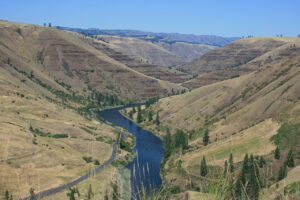
Hot spots may produce volcanic islands like the Hawaiian Islands and the Azores in oceanic regions. In continental settings, they also produce volcanic centers like Yellowstone, or flood basalts like those in eastern Washington, Oregon, and Idaho. Figure 2.14 is a photo of horizontal layers of flood basalt exposed in slopes above the Grande Ronde River in eastern Oregon. These basalts are products of the same hot spot that underlies Yellowstone National Park today. In North America, we also find volcanic rocks in all major mountain ranges and in the Canadian Shield where eroded remains of ancient mountains remain.
| Chapter 16 Section 16.2 contains many photos of volcanic rocks in hand specimen and in thin section. If you want to know what they look like, go there. |
2.2.2 Plutonic Rocks
|
|
Plutonic rocks form in all the same geological settings as volcanic rocks. Yet, because they crystallize underground, unless brought to the surface in some way, we may never see them. We find plutonic rocks exposed in uplifted mountain ranges and in shield regions where erosion has uncovered the underlying roots of ancient mountains. Figure 2.15 is a photo of a small pluton in North Carolina’s Appalachian Mountains, and Figure 2.16 is a closeup of the rock that makes up the pluton. The black bar at the top of the photo is 1 cm across. This granitic rock contains relatively coarse quartz and two kinds of feldspar, along with minor black biotite.
While accounting for a small percentage of the outcrops at Earth’s surface, various kinds of plutonic rocks make up the deeper parts of Earth’s crust in both continental and oceanic regions. So plutonic rocks are both diverse and important. They also make up much of Earth’s mantle. Still, most igneous rocks that we study formed in the crust, simply because those that originated in the mantle rarely make it to the surface for us to see. The exceptions include (1) slivers of oceanic mantle uplifted and attached to continents through a process called obduction, (2) some pieces of solid igneous rock, termed xenoliths, carried from the mantle to the surface by rising magmas, and (3) tectonic slices that have incorporated into mountain belts during orogenies. Although most plutonic rocks that we see crystallized in the crust, the magmas that produced them often derived initially from the mantle. Consequently, studying igneous rocks gives us important information about the nature of the mantle and the processes that occur there.
| Chapter 16 Section 16.1 contains many photos of plutonic rocks in hand specimen and in thin section. If you want to know what they look like, go there. |
2.2.3 Subvolcanic Rocks
Some in-between rocks have features that are partly extrusive and partly intrusive. They form when magma cools at very shallow depths in Earth, and we call them subvolcanic rocks, or hypabyssal rocks. These rocks are generally dikes or sills, or related intrusive rocks, that contain fine to very fine grains. Volcanic necks, such as Shiprock (Box 2-2) commonly contain subvolcanic rocks. Necks form when magma hardens underground in a volcanic vent, but is later exposed by erosion of surrounding rocks. Necks may consist of homogeneous fine-grained rock, but some contain fragmental material. Besides dikes, sills, and necks, other subvolcanic rocks develop beneath lava domes when very viscous lava piles up in one place because it does not flow easily. The tops of the domes contain lavas but magma at the base crystallizes much like an intrusive rock.
2.3 Igneous Rock Compositions
Volcanic and plutonic rocks have similar compositions. We typically talk about those compositions in terms of elemental oxides. The most significant oxide components in igneous rocks are SiO2, Al2O3, FeO, Fe2O3, CaO, Na2O, K2O, and MgO. Except for rare occurrences, all other chemical components sum to less than 1 wt%. Silica (SiO2) is the largest component in all but some exceptionally rare igneous rocks. It makes up nearly half, or more, of most igneous rock composition and allows us to divide rocks into three general compositions categories: mafic, intermediate, and silicic. Mafic rocks, such as basalt and gabbro generally contain 45-55 wt% silica. Silicic rocks (also sometimes called felsic rocks), such as rhyolite and granite, contain more than 65 wt% silica. Intermediate rocks fall between. Figure 2.18 shows these relationships.
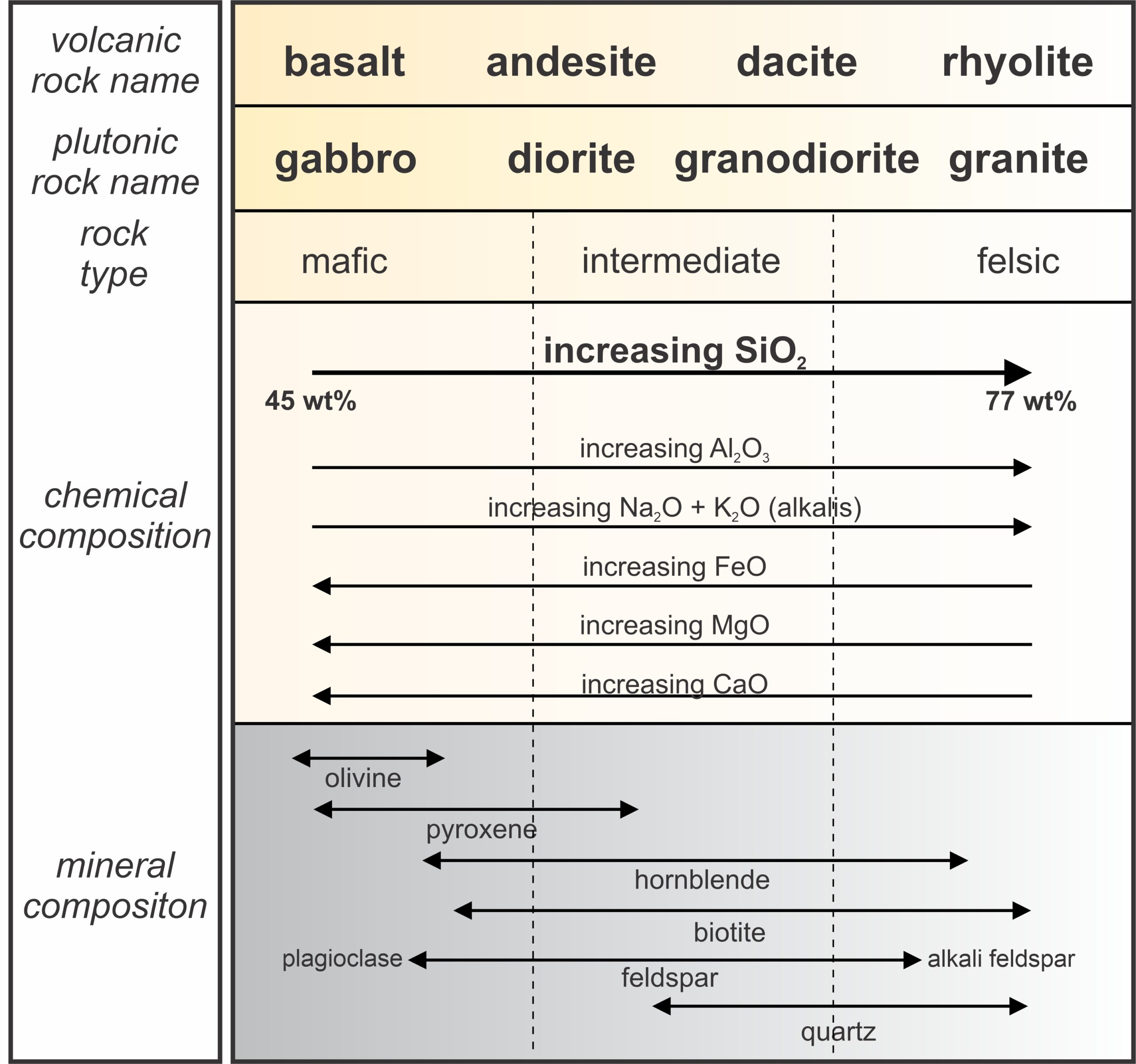
Typical volcanic rocks range from basalt (mafic), the most common volcanic rock, to rhyolite (silicic). There are many intermediate kinds but, for simplicity, Figure 2.18 includes only andesite and dacite. Basalts generally contain 45-52 wt% SiO2, and rhyolites 70–77 wt% SiO2. Andesite and dacite fall between. Silica content can be a simple way to differentiate different rock species – to distinguish basalt from andesite, from dacite, from rhyolite – but other chemical components vary too, sometimes making things complex. For example, basalt may contain 5 to 14 wt% FeO and 5 to 12 wt% MgO. So, basalt compositions are quite variable in several ways. Leaving some of the complexities aside, as depicted in Figure 2.18, silicic rocks are generally richer in alkalis and alumina than mafic rocks, and mafic rocks are richer in CaO, MgO, and FeO.
Plutonic rock compositions cover the same range as volcanic rocks. Yet, while basalt (mafic) is the most common volcanic rock that we see, granites and granodiorite (silicic) are the most common plutonic rocks. Typical plutonic rocks vary from gabbro (which has composition equivalent to basalt) to granite (which has composition equivalent to rhyolite) with, perhaps, a bit more silica. Diorite and granodiorite have compositions between gabbro and granite (Figure 2.18).
2.4 Obsidian and Vesicular Rocks
Silicic magmas, which start at lower temperatures than mafic magmas, may solidify largely or entirely to form obsidian (volcanic glass). Figure 2.19 is an example. Obsidian is unstable and will, over time, devitrify (become partially or wholly crystalline). Consequently, it is uncommon to find obsidian older than 10 or 20 million years. Figure 2.20 shows a pig carved out of snowflake obsidian. The “snowflakes” consist of cristobalite (a polymorph of quartz) crystals that formed by devitrification of once homogeneous solid glass. Although silicic rocks are the most likely to contain glass, volcanic rocks of other compositions sometimes do too.
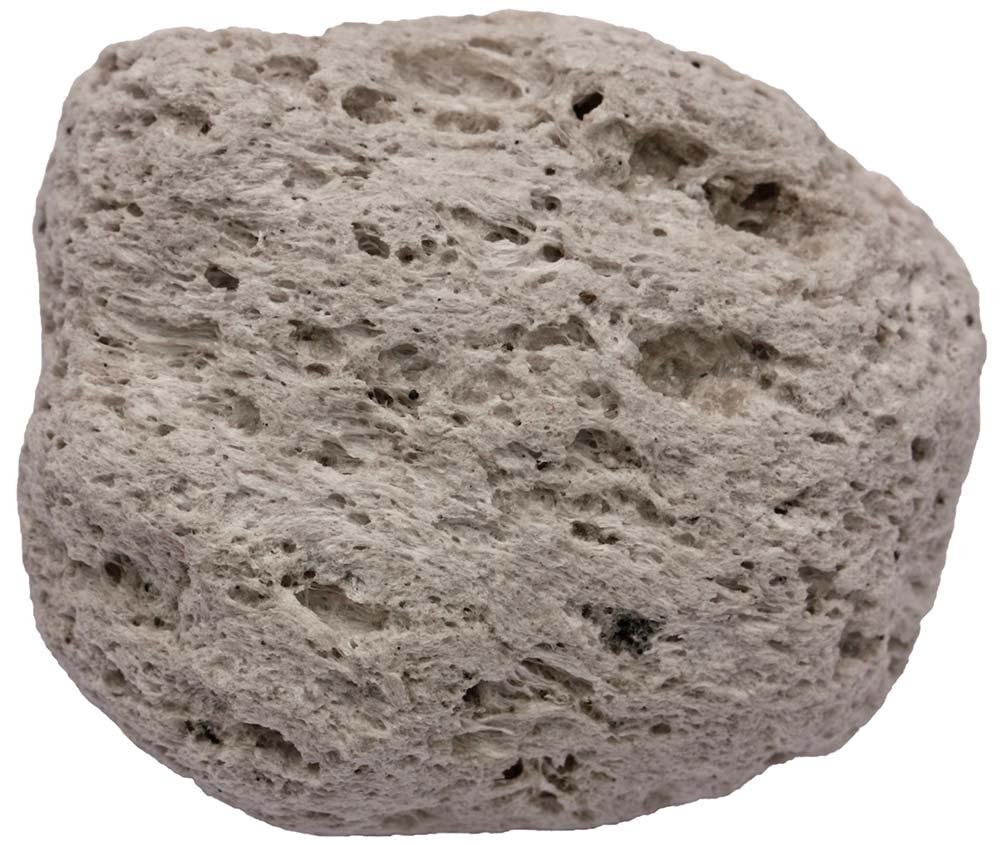
The adjective vesicular describes rocks that contain many obvious holes created by gas bubbles during crystallization of a frothy magma. The holes are vesicles. Pumice, a light-colored rock that forms during explosive eruptions, is the most common example of a vesicular rock (Figure 2.21). Pumice is mostly volcanic glass but may contain small mineral crystals. Some pumice contains so many holes that it will float on water like a sponge. We will see an example of this later in Figure 4.40. Most pumice is silicic to intermediate in composition. Other composition rocks, too, may contain vesicles. For example, the opening photo in Chapter 1 was a photo of a vesicular basalt that contained millimeter sized green olivine crystals.

Pumice is not the only kind of vesicular rock. Scoria, also called cinder, is an extremely vesicular form of basalt (mafic) that often appears to have the same texture as pumice. However the vesicles in scoria are generally larger with thicker walls than vesicles in pumice. And scoria is dark colored and denser than pumice (Figure 2.22). Like pumice, scoria may contain small mineral crystals, and some scoria is mostly crystalline and contains only a small amount of glass. Scoria may form as part of a lava flow but, more commonly is the product of an explosive eruption. Scoria is found in many places, and is sometimes used for landscaping.
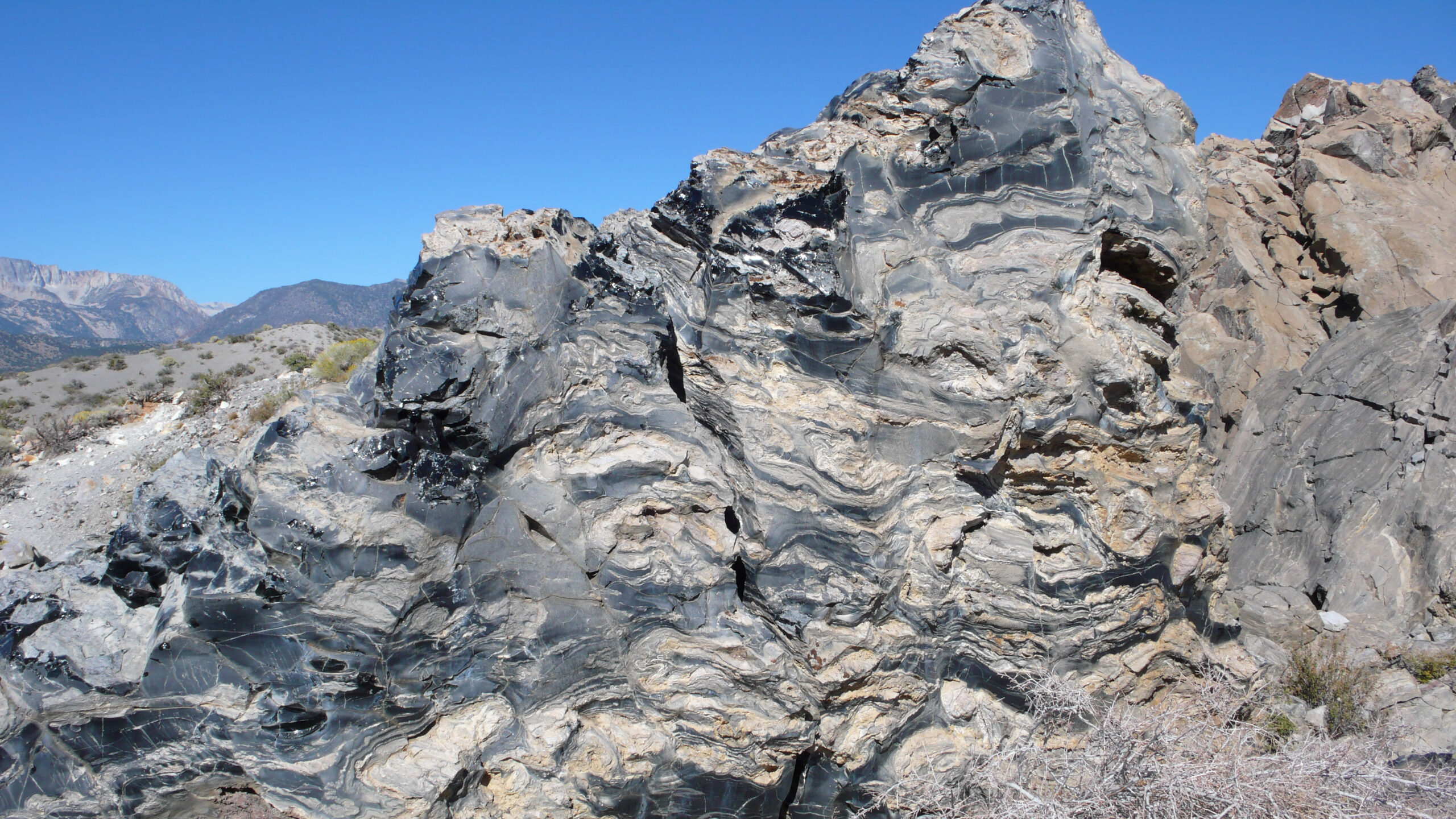
The outcrop seen in Figure 2.23, near Mono Lake, California, contains obsidian (black) and pumice (gray). The two have the same composition but the pumice is full of vesicles. The obsidian solidified under pressure, so no gas bubbles formed to give the rock a vesicular texture. The combination of obsidian and pumice in a single outcrop is quite common.
2.5 Minerals in Igneous Rocks
The minerals in different igneous rocks reflect overall rock composition. The bottom part of Figure 2.18 shows how mineral content can vary from mafic to silicic rocks. Rocks rich in silica or alkalis, such as granite, contain quartz (SiO2) and alkali feldspar (KAlSi3O8). Those that are silica-poor, such as basalt, contain no quartz. Rocks that are alkali-poor and may contain Ca-rich plagioclase feldspar instead of alkali feldspar. Mafic minerals such as olivine and pyroxene, which dominate mafic rocks, are generally absent in intermediate and silicic rocks, because such rocks contain relatively small amounts of Fe and Mg. The minerals listed in Figure 2.18, the major mineral components of most igneous rocks, are typically visible in plutonic rocks. But, due to fine grain size, these minerals may be impossible to see in volcanic rocks, even if they are present.
Petrologists classify minerals in several ways, commonly dividing them into two categories. The first category, mafic minerals, includes all ferromagnesian minerals (minerals rich in iron and magnesium and relatively poor in silicon compared with other minerals). These minerals generally have a dark color. Olivine, pyroxene, amphibole, and biotite are examples. The mafic rock in Figure 2.24 contains examples: olive-green olivine, dark brown orthopyroxene, and a small amount of emerald-green clinopyroxene that is hard to see.
|
|
|
Silicic minerals generally contain little iron and magnesium, and have a light color. They are rich in lighter elements such as silicon, oxygen, aluminum, sodium, and potassium. The most common silicic minerals include quartz, muscovite, and feldspars. The granite in Figure 2.25 contains examples: gray glassy quartz, with white and pinkish feldspars. It also contains black biotite (mafic). Because the minerals present in rocks reflect rock composition, mafic minerals dominate mafic rocks. Silicic minerals dominate silicic rocks. Consequently, mafic rocks have darker colors than silicic rocks.
2.5.1 Primary Minerals
The minerals created when a rock initially crystallizes are the rock’s primary minerals, and classification systems for intrusive rocks are based on primary mineralogy. Because intrusive rocks are generally coarse-grained, we can often identify the major minerals in an outcrop, perhaps with the aid of a hand lens, to give a rock a name. Sometimes, however, we must examine thin sections to be certain about the mineralogy.
Primary minerals contrast with secondary minerals that form later due to weathering or other forms of alteration when a rock interacts with the environment. Usually, primary minerals do not crystallize all at once, but instead form sequentially, one or more at a time. Evidence for sequential crystallization comes from the porphyritic textures seen in many rocks. The textures tell us that some mineral crystals developed over much longer times than others. See Figure 1.1, previous chapter, for an excellent example; also the photos of porphyries earlier in this chapter. Other aspects of rock texture provide additional evidence. For example, the first crystals to form may be euhedral (having well-developed flat crystal faces) but may be surrounded by anhedral (no flat faces) grains of a different mineral filling gaps between them.
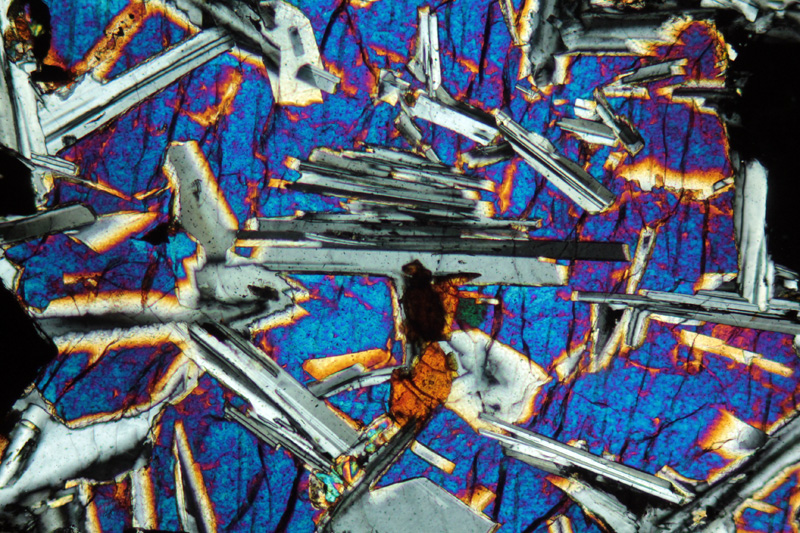
Figure 2.26 is a photo of a typical gabbro in thin section. The photo was taken using a petrographic microscope with crossed polarizing filters and, so, the colors seen are not true mineral colors. Grains with gray and white stripes are plagioclase. The mineral that appears blue and red, and that has filled space between the plagioclase crystals, is augite, a pyroxene. The texture tells us that plagioclase crystallized first and the interstitial (between grains) augite formed later. This is a texture common to most gabbros and to some rocks of other compositions.
The number of common primary minerals in igneous rocks is surprisingly small (Table 2.1, below). No matter the overall rock composition, the dominant minerals are usually some combination of quartz, feldspar, mica, amphibole, pyroxene, or olivine. However, two kinds of feldspars, two major kinds of micas, several possible amphiboles, and several possible pyroxenes may be present. Additionally, these minerals, except quartz, can have variable compositions that reflect magma composition. In most rocks, small amounts of minor minerals accompany the major minerals.
| Table 2.1. Common Primary Minerals in Igneous Rocks |
|
| Mineral | typical composition and occurrences in igneous rocks |
| Quartz | Quartz is the only common primary silica polymorph. Quartz is generally restricted to silicic or intermediate rocks. |
| K-feldspar | Most alkali feldspar is potassium feldspar that may contain variable amounts of sodium. K-feldspar is restricted to silicic or intermediate rocks. |
| Plagioclase | Plagioclase ranges from albite (Na-rich) in some silicic rocks to anorthite (Ca-rich) in mafic rocks. |
| Muscovite | Muscovite is restricted to silicic (rarely intermediate) rocks, and its composition is generally close to its end-member formula. |
| Biotite | Biotite occurs most commonly in silicic rocks, less commonly in some intermediate rocks, and rarely in any others. Composition varies primarily between biotite’s Mg- and Fe-end members, phlogopite and annite. |
| Amphibole | Amphibole varies widely in composition. It is found most often in intermediate rocks but may be present in rocks of other compositions. By far, the most common amphibole is hornblende, but other varieties may be present, especially in alkalic rocks. |
| Pyroxene | Both clinopyroxene (mainly augite) and orthopyroxene may be present in mafic rocks, less commonly in intermediate rocks, and rarely in silicic rocks. Several different Na-rich pyroxenes are found in alkalic rocks. |
| Olivine | Olivine’s composition varies primarily between its Mg- and Fe-end members, forsterite and fayalite. It is generally only found in mafic or ultramafic rocks. |
| Accessory minerals | Besides the minerals listed above, others are common as accessories: titanite, zircon, epidote, rutile, topaz, corundum, fluorite, magnetite, ilmenite, allanite, garnet, chromite, spinel, monazite, and tourmaline. |
Why do only a few minerals dominate igneous rocks? There are two main reasons: magma compositions and thermodynamics. Most magmas contain the same major elements, and the most abundant minerals present consist of those elements. In weight percent, oxygen makes up about half of most magmas and silicon accounts for about a quarter. (So, silicate minerals dominate igneous rocks!) Aluminum comprises about 8% of most magmas. Other elements are more variable: iron and calcium make up 1 to 10%; potassium, magnesium, and titanium make up half a percent to 5%; and sodium accounts for 2-3%. Other elements are generally present only in very small amounts. All these elements could potentially combine in many ways to make many different minerals. Yet they do not. Natural processes always try to minimize energy. The Laws of Thermodynamics tell us that the minerals that form will be those that produce a rock with the lowest amount of chemical energy. Under most conditions, those minerals are the ones listed in the table above.
2.5.2 Essential and Accessory Minerals
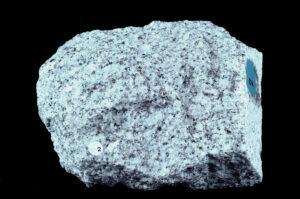
Petrologists often distinguish two fundamental kinds of primary minerals in rocks. Essential minerals are those that must be present for a rock to have the name that it does. Varietal and accessory minerals include any other minerals that may or may not be present. For example, by definition, all granites contain K-feldspar and quartz. Granites may also contain plagioclase, muscovite, biotite, or amphibole, but these are not essential for a rock to be called granite. The granite seen in Figure 2.27, for example, contains quartz and K-feldspar as essential minerals. It also contains muscovite, biotite, and plagioclase. Similarly, gabbro always contains essential pyroxene and plagioclase and may also contain accessory olivine or amphibole. Other rocks, too, commonly contain a number of different minerals beyond those essential to the rock’s name.
The essential minerals in different kinds of rock depend in part on the classification system used. Many systems have been proposed for naming rocks, and they do not all give the same names. For plutonic rocks, because they are generally coarsely crystalline and contain no glass, essential minerals are absolutely essential – depending on the classification scheme being used. They must be present for rocks to have the names they do, and conversely, if present they give the rocks their names. The notion of essential minerals is less applicable to volcanic rocks because they may contain glass instead of minerals or the minerals present may be too fine grained to be readily identified.
The last row of Table 2.1 lists common accessory minerals in igneous rocks, but any of the minerals in the table can be accessory minerals if they are in a rock but are not essential to the rock name. When we look at a rock, we may overlook accessory minerals if they are present in small amounts. If present in significant amounts, but not essential to the rock name, accessory minerals can be considered varietal minerals, also called characterizing accessory minerals. Typical characterizing accessories include biotite, muscovite, amphibole, pyroxene, olivine, and glass. Their presence can be used to modify a rock name. For example, an olivine gabbro is a particular type of gabbro that contains olivine as an accessory mineral, and a hornblende granite contains hornblende besides essential K-feldspar and quartz. The granite in Figure 2.27 is a muscovite-biotite granite.
2.5.3 Mineral Modes

Figure 2.28 compares the minerals found in five of the most common plutonic rocks: granite, granodiorite, diorite, gabbro, and peridotite. The relative amounts of different minerals, expressed as weight percentages (by the vertical scale), are the mineral modes of the rocks. Modes vary depending on overall rock composition. For example this diagram tells us that the most silicic granites (plotting on the left edge of the diagram) contain about 50% K-feldspar, perhaps 30% quartz, and lesser amounts of plagioclase, muscovite, and biotite. And mafic rocks, such as gabbro, contain about 60 wt% pyroxene with lesser amounts of plagioclase and olivine.
Figure 2.28 also includes names of volcanic rocks but this is a bit misleading because the names of volcanic rocks better reflect overall rock composition than rock mineralogy. As pointed out previously, many volcanic rocks contain significant amounts of glass and sometimes no visible mineral crystals at all. So, although they could be present, we may not be able to see any of the minerals in Figure 2.28.
Modal diagrams of this sort (Figure 2.28) are, at best, imprecise generalizations. Consider granite. The diagram suggests that – besides quartz and K-feldspar – granite contains plagioclase, muscovite, biotite, and maybe amphibole. Many granites, however, lack one or all these minerals. So, modal diagrams may be useful for some purposes but are incorrect in detail because mineral assemblages are variable for a given kind of rock. Additionally, modal diagrams do not include minor minerals. Still, these diagrams do an excellent job of reminding us that the minerals present in any rock reflect the rock’s overall composition.
2.5.4 Secondary Minerals
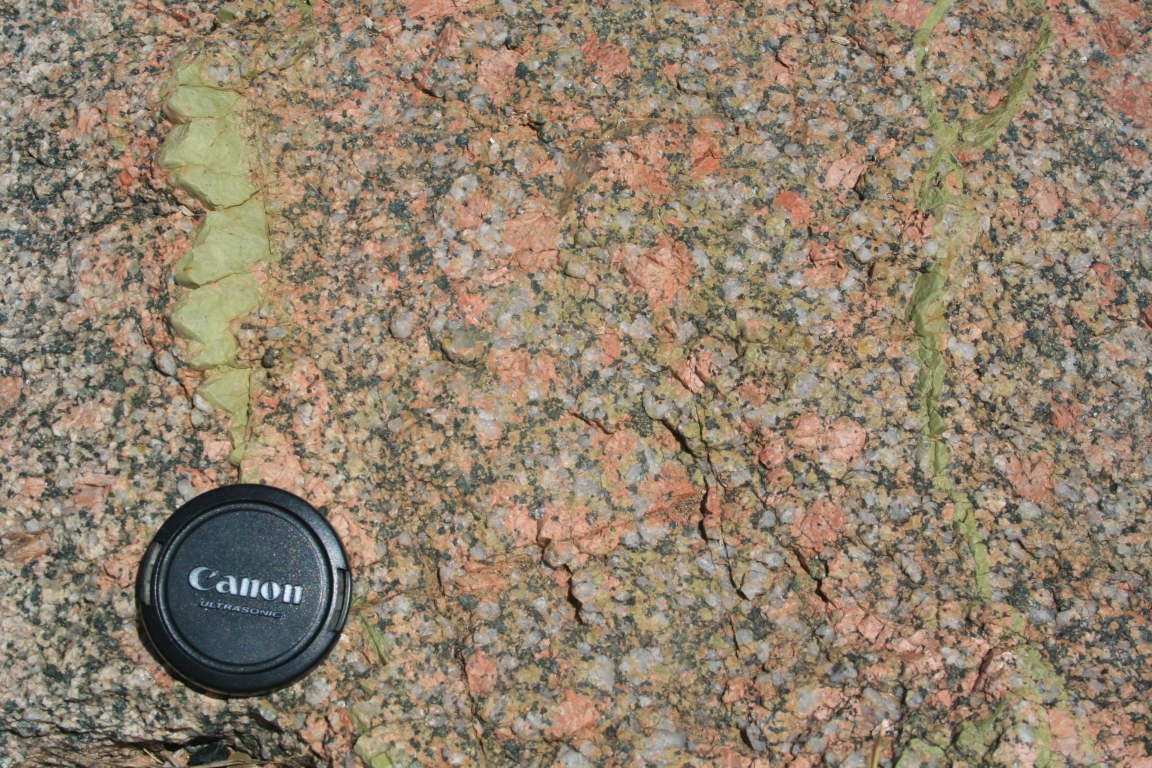
Secondary minerals include many alteration products of primary minerals. In silicic and intermediate rocks, for example, feldspars and micas commonly alter partially or wholly to epidote, chlorite or clays. Many secondary minerals are hydrous, forming by reaction of primary minerals with water flowing through a rock. They may form by in situ alteration of an original mineral grain, or in secondary veins. This photo (Figure 2.29) is a view of the Ruin Granite from near Globe, Arizona. The rock contains quartz (gray, but hard to see), orthoclase (pinkish), and plagioclase (white). Individual plagioclase grains are altering to light-green secondary epidote. Additional epidote (pistachio-green) is in easily-seen secondary veins. Besides epidote and clays, other common hydrous minerals that form from feldspars include minerals of the zeolite group.
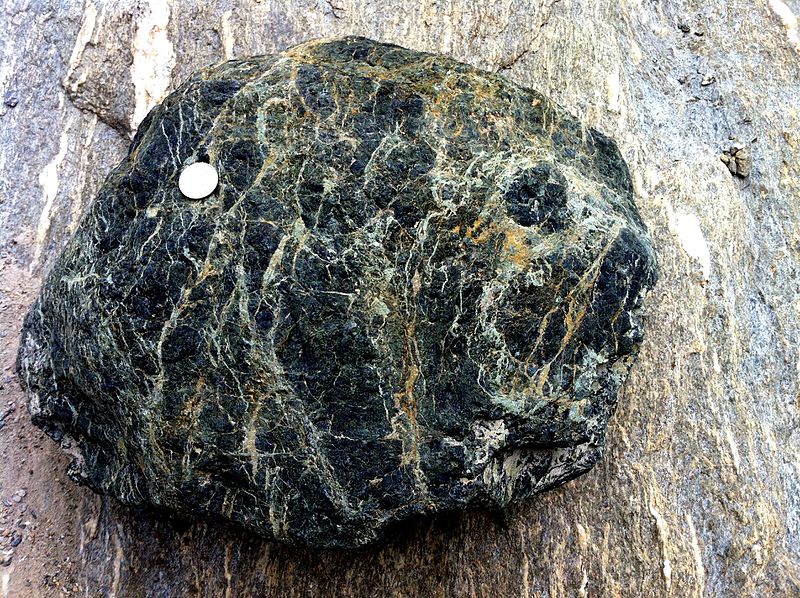
Many ferromagnesian rocks contain minerals that are unstable at Earth’s surface. In these rocks, mafic minerals commonly alter partly or wholly when exposed to water and air. Typical alteration products include chlorite and serpentine, both hydrous minerals, and oxides including magnetite and hematite. Figure 2.30 shows an altered rock called serpentinite from the Maurienne Valley in the French Alps. The rock originally contained primary olivine and augite. Subsequently, secondary minerals, mostly dark green and gray serpentine and iron oxides, replaced the primary minerals. Besides serpentine and oxides, other common secondary minerals in ferromagnesian rocks include chlorite, carbonates, oxides, and hydroxides. Ultramafic rocks, in particular, alter and weather rapidly. Some large ultramafic bodies, which may appear unaltered when viewed in an outcrop, are made nearly entirely of serpentine.
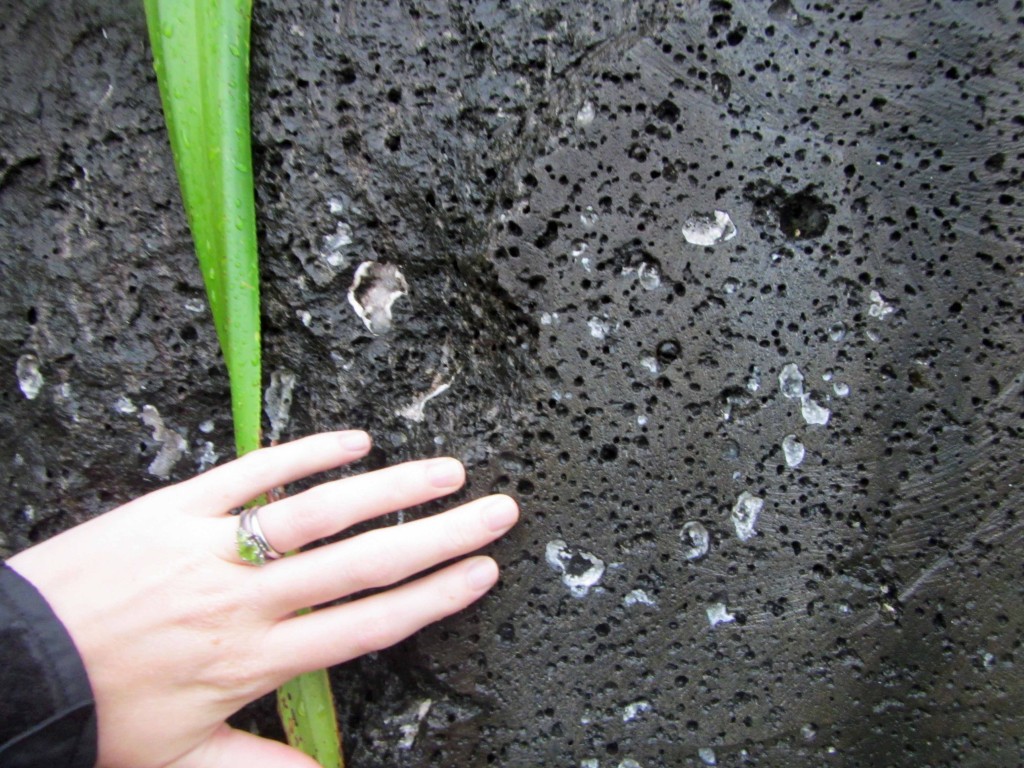
Secondary minerals may form when flowing pore or surface water deposits minerals in vesicles, creating features called amygdules. This photo (Figure 2.31) is a vesicular basalt with white minerals on vesicle walls. Zeolites are typical amygdule minerals, but calcite, quartz, and several others are also common. Amygdaloidal rocks, such as the one shown, are common and widespread.
2.6 Silicic Versus Mafic Magmas
Silicic magmas have high viscosity compared with mafic magmas. Their higher silica content mean they are more polymerized. In effect, they are not completely melted but contain silica chains. So, they move sluggishly through the crust and may not make it to the surface. The slow magma movement, or no movement, may lead to silica-rich plutonic rocks. And sometimes, silicic magmas boil and lose gases and fluidity rapidly, also causing them to solidify at depth. For these reasons, Silicic sills, dikes, and plutons are common. Most of the largest known plutons have Si-rich compositions. When many such plutons form in the same region, they may create very large features called batholiths. But individual plutons within a batholith may be difficult to distinguish if they have similar compositions.
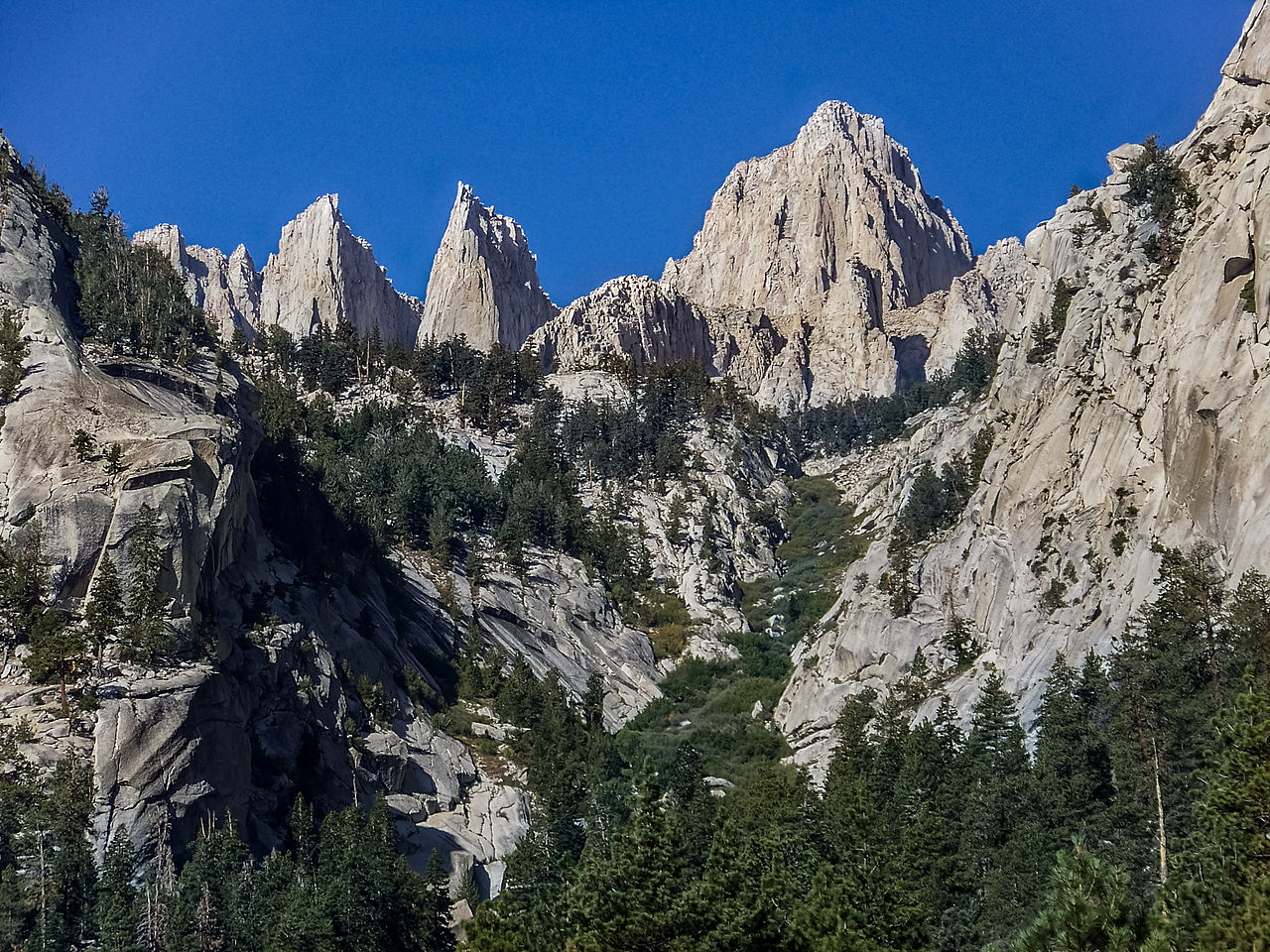
Batholiths can be gigantic. For example, the Sierra Nevada Batholith of California, further discussed extensively in Chapter 7, runs the entire length of the Sierra Nevada Mountains. The Coast Range Batholith of British Columbia is even larger.
Figure 2.32 is a view of the High Sierra, from near Lone Pine California. The largest monolith in this photograph is Mt. Whitney, the highest peak in the Sierra Nevada Mountains. The peak left of Whitney is Keeler Needle, and left of that is Crooks Peak. All three consist of granites and related rocks belonging to the Sierra Nevada Batholith. The batholith formed 150 to 80 million years ago. At one time extensive volcanic rocks were probably present in the same region. The volcanic rocks, however, have eroded away and plutonic rocks that were once buried are exposed at the surface.
|
|
|
Mafic and intermediate composition magmas are hotter and less viscous than silicic magmas. This allows them to move more quickly and have a better chance to reach the surface than their silicic counterparts. If they reach the surface, mafic and intermediate magmas produce lava flows that may be localized around a single volcanic vent, or that may cover vast regions. Besides producing lava flows, mafic and intermediate magmas often form dikes or other small intrusive rock bodies and, less commonly, plutons of small to large sizes.
Figure 2.33 is a photo of tourists at the Fagradalsfjall Volcano in Iceland in March 2021. The volcano has multiple vents but overall is 3-5 kilometers across. This volcano is quite similar to the ones erupting on Hawaii today. Figure 2.34 is a photo of cliffs formed from basalt flows near Mumbai on the west coast of India. These basalts are part of the Deccan Traps, a huge basalt province with piled up flows 2,000 meters thick. The Traps cover an area of about 500,000 square kilometers, five times the size of the entire island of Iceland. The Deccan province formed about 66 million years ago.
● Figure CreditsUncredited graphics/photos came from the authors and other primary contributors to this book. 2.0 (opening photo) Granite in Joshua Tree National Park, Brocken Inaglory, Wikimedia Commons. |
